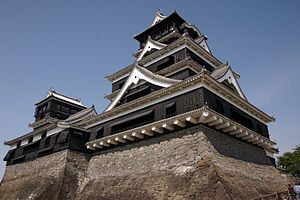Kumamoto Castle
| Kumamoto Castle 熊本城 |
|
|---|---|
| Kumamoto, Kumamoto Prefecture, Japan | |
 |
|
| Type | Azuchi-Momoyama castle |
| Built | |
| Built by |
|
| Construction materials |
Wood, stone, plaster, tile |
| In use | 1467-1874 [1] |
| Demolished | 1877 (Satsuma Rebellion) [1] |
| Current condition |
Restored in 1960 and 1998-2008.[1] |
| Controlled by | Ideta clan (1469-1496) Kanokogi clan (1496-1550) Jou clan (1550-1587) Sassa clan (1587-1588) Kato clan (1588-1632) Hosokawa clan (1632-1871) Japan (1871-present) |
Kumamoto Castle (熊本城 Kumamoto-jō) is a hilltop Japanese castle located in Kumamoto in Kumamoto Prefecture.[1] It was a large and extremely well fortified castle. The castle keep (天守閣 tenshukaku) is a concrete reconstruction built in 1960,[1] but several ancillary wooden buildings remain of the original castle. Kumamoto Castle is considered one of the three premier castles in Japan, along with Himeji Castle and Matsumoto Castle.[2] Thirteen structures in the castle complex are designated Important Cultural Property.[1]
Contents |
[edit] History
Kumamoto Castle's history dates to 1467, when fortifications were established by Ideta Hidenobu.[1] In 1496, these fortifications were expanded by Kanokogi Chikakazu.[1] In 1588, Katō Kiyomasa was transferred to the early incarnation of Kumamoto Castle.[1] From 1601 to 1607, Kiyomasa greatly expanded the castle, transforming it into a castle complex with 49 turrets, 18 turret gates, and 29 smaller gates.[1] The smaller castle tower, built sometime after the keep, had several facilities including a well and kitchen.[1] In 1610, the Honmaru Goten Palace was completed.[1] The castle complex measures roughly 1.6 km (0.99 mi) from east to west, and measures 1.2 km (0.75 mi) from north to south.[3] The castle keep is 30.3 m (99.4 ft) tall.[3]
The castle was besieged in 1877 during the Satsuma Rebellion, and the castle keep and other parts were burned down.[1] 13 of the buildings in the castle complex were undamaged, and have been designated Important Cultural Properties.[3] In 1960, the castle keep was reconstructed using concrete.[1] From 1998 to 2008, the castle complex underwent restoration work, during which most of the 17th century structures were rebuilt.[1]
The signature curved stone walls, known as musha-gaeshi, as well as wooden overhangs, were designed to prevent attackers from penetrating the castle. Rock falls were also used as deterrents.
In nearby San-no-Maru Park is the Hosokawa Gyobu-tei, the former residence of the Hosokawa clan, the daimyo of Higo Province during the Edo period. This traditional wooden mansion has a fine Japanese garden located in its grounds.
Kumamoto Castle recently celebrated its 400th anniversary. On December 7, 2007, a large-scale renovation of the Lord's Inner Palace was completed. A public ceremony for the restoration was held on April 20, 2008.
[edit] Gallery
Old photographs
Present exterior
[edit] References
- ^ a b c d e f g h i j k l m n o p q r s t u v w x y O'Grady, Daniel. "Kumamoto Castle - 熊本城". Japanese Castle Explorer. http://www.japanese-castle-explorer.com/castle_profile.html?name=Kumamoto. Retrieved 2010-07-13.
- ^ "The Three Famous Castles of Japan". Kobayashi Travel Service. http://www.ktshawaii.com/DestinationArticles/TheThreeFamousCastlesofJapan/tabid/156/Default.aspx. Retrieved 2010-07-04.
- ^ a b c "Tourist Facilities of Japan - Kumamoto Castle". Japan National Tourism Organization. http://www.jnto.go.jp/eng/arrange/attractions/facilities/castles/83dn3a000000edqt.html. Retrieved 2010-07-15.
- Further reading
- Schmorleitz, Morton S. (1974). Castles in Japan. Tokyo: Charles E. Tuttle Co.. pp. 114–116. ISBN 0-8084-1102-4.
- Motoo, Hinago (1986). Japanese Castles. Tokyo: Kodansha. pp. 200 pages. ISBN 0-87011-766-1.
[edit] External links
| Wikimedia Commons has media related to: Kumamoto Castle |
Coordinates: 32°48′22″N 130°42′21″E / 32.806063°N 130.705972°E






